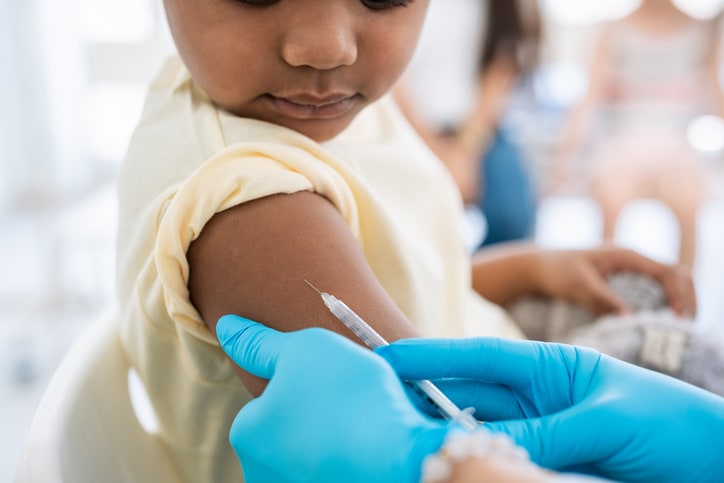The long wait for a COVID vaccine for kids under 5 is officially over. Last week, both the U.S Food and Drug Administration (FDA) and the Centers for Disease Control and Prevention (CDC) voted to give emergency use authorization to two separate vaccine series for young kids.
The approval of these vaccines from Moderna and Pfizer-BioNTech means that every child ages 6 months and older in the U.S. is now eligible for vaccination. But having multiple options also means that parents and caregivers have plenty of questions about when and where the shots will be available and which vaccine series to get.
Here, pediatricians and infectious disease experts answer those questions and break down all of the latest information about COVID vaccines for kids under 5.
Where can I get a COVID vaccine for kids under 5?
As pledged, the Biden administration started shipping vaccine doses to states immediately following the FDA authorization. Both the Moderna and Pfizer-BioNTech vaccine series are available beginning this week, June 20, at qualified healthcare providers, including:
- Pediatric practices.
- Pharmacies.
- Local health departments.
- Vaccine clinics.
- Health centers.
Federal law prohibits pharmacists in many states from administering vaccines to children under 3 years old. You can contact your child’s pediatrician or your local health department to inquire about the best location to get young kids vaccinated.
For a list of vaccine locations near you, use the free search tool at Vaccines.gov.
Are COVID vaccines free for kids?
Yes, COVID vaccines are free to the public. This includes everyone ages 6 months and older, regardless of insurance or immigration status.
Moderna vs. Pfizer: Which vaccine should I choose for my child?
Two different vaccines have been approved for use in kids under 5, which means parents and caregivers have a choice to make. The first thing to know is that both vaccines are safe, offer adequate protection and have similar side effect profiles, says Dr. Zachary Hoy, a pediatric infectious diseases specialist with Pediatrix Nashville Pediatric Infectious Disease.
“Parents have to weigh the risks and benefits for each vaccine, and I strongly encourage them to make appointments with the pediatrician, even if it’s a telehealth appointment, to discuss COVID vaccines.”
— DR. ZACHARY HOY, PEDIATRIC INFECTIOUS DISEASES SPECIALIST
Here’s what you can expect from each type of vaccine:
Moderna vaccine
- Requires two doses at about one-quarter the strength of the adult dosage.
- The doses take place one month apart.
- Kids are fully protected six weeks from their first shot.
Pfizer-BioNTech vaccine
- Requires three doses at about one-tenth the strength of the adult dosage.
- The second dose is given three weeks after the first.
- The third dose is given eight weeks after the second.
- Kids are fully protected 13 weeks from their first shot.
In addition to the different dosages, Pfizer-BioNTech and Moderna each report different efficacy data for the shots as well. In clinical trials:
- Moderna shows 37.5% efficacy in children 2 to less than 6 years of age and 43.7% in children 6 months to less than 2 years of age.
- Pfizer reports 80.3% efficacy in a preliminary sample of kids ages 6 months to 6 years, though more data is still being collected.
“Both the Pfizer and Moderna COVID-19 vaccines are mRNA vaccines, so they work similarly in teaching our bodies how to make a piece of a protein and trigger an immune response,” says Dr. Lyndy Jones, a pediatrician and co-medical director at Phoenix Children’s Pediatrics.
“Both the Pfizer and Moderna COVID-19 vaccines are mRNA vaccines, so they work similarly in teaching our bodies how to make a piece of a protein and trigger an immune response.”
— DR. LYNDY JONES, PEDIATRICIAN
Dr. Hoy says timing and the number of shots may play the biggest role in determining which vaccine parents choose. “Parents have to weigh the risks and benefits for each vaccine, and I strongly encourage them to make appointments with the pediatrician, even if it’s a telehealth appointment, to discuss COVID vaccines,” he says.
Are COVID vaccines safe for young kids?
Children’s health experts say both the Moderna and Pfizer-BioNTech vaccines are equally safe for kids under 5.
What COVID vaccine side effects may occur in kids under 5?
In children 3 years and younger, the most common side effects of COVID vaccination include:
- Pain where the shot was given.
- Swollen lymph nodes.
- Irritability or crying.
- Sleepiness.
- Loss of appetite.
For children 4 years and older, the most common side effects are:
- Pain, swelling and redness where the shot was given.
- Swollen lymph nodes.
- Fever.
- Tiredness.
- Headache.
- Chills.
- Muscle or joint pain.
“This is a similar side effect profile to any childhood vaccine,” says Dr. Wassim Ballan, a pediatric infectious disease specialist at Phoenix Children’s Hospital. “Side effects within seven days of getting vaccinated are common but mostly mild. Side effects, such as fever, chills, tiredness and headache, are more common after the second dose of the vaccine.”
“Side effects within seven days of getting vaccinated are common but mostly mild. Side effects, such as fever, chills, tiredness and headache, are more common after the second dose of the vaccine.”
— DR. WASSIM BALLAN, PEDIATRIC INFECTIOUS DISEASE SPECIALIST
Zero cases of myocarditis were reported in the clinical trials for either of the under-5 vaccines, and Ballan says the risk in young kids is generally low.
“The concern for myocarditis is higher in people experiencing COVID-19 infection compared to those who report myocarditis after vaccination,” Ballan adds. “Those who have reported mild myocarditis after getting vaccinated were in an older age group, and we suspect that was an interaction of puberty hormones and the immune response to the vaccine.”
My child is healthy. Why do they need a COVID vaccine?
“It’s true that the majority of kids get mild to moderate disease when infected with COVID,” says Dr. Katelyn Jetelina, an epidemiologist and the director of population health analytics at the Meadows Mental Health Policy Institute in Texas. “However, even healthy kids can be hospitalized for COVID-19. In fact, among kids hospitalized during the omicron wave, 30-40% had no underlying health conditions.”
Pediatric COVID-19 infections have been linked to a number of ongoing health issues, including:
- The onset of Multisystem Inflammatory Syndrome (MIS-C), a serious post-COVID syndrome.
- An increased risk of diabetes, myocarditis and acute kidney disease.
- A higher risk for long COVID.
Since the beginning of the pandemic, 442 children ages 0-4 years old have died from COVID-19. While that number is low compared to the death toll in other age groups, it is high when compared to the number of young kids who die from other common infectious diseases each year. By comparison, only 68-87 kids ages 0-4 died from the flu each year between 2018-2020.
“We have no way to predict who will and will not be hospitalized,” Dr. Jetelina adds. “The best way to prevent it, in the safest way possible, is through vaccination.”
Does my child need a vaccine if they already had COVID?
Even if a child has had COVID-19, they should still get vaccinated, says Dr. Ballan. “Emerging evidence indicates that people can get added protection by getting vaccinated after having been infected with the virus that causes COVID-19,” he explains.
“Emerging evidence indicates that people can get added protection by getting vaccinated after having been infected with the virus that causes COVID-19.”
— DR. WASSIM BALLAN, PEDIATRIC INFECTIOUS DISEASE SPECIALIST
Dr. Hoy adds that, after a COVID infection, it’s important to consult your child’s pediatrician to discuss timing and the best plan for their individual needs.
Should I wait until cold and flu season to get my child vaccinated?
The Biden administration has warned that a COVID wave could infect more than 100 million people this fall. For this reason, some have wondered if it’s better to vaccinate kids in the fall when they would typically get other seasonal vaccines, like the flu shot. But experts warn that COVID is still circulating throughout the community, and kids need protection now.
“We are currently experiencing the second largest case surge since the beginning of the pandemic,” Dr. Jetelina says. “Many people don’t know this because cases are significantly under-reported. We don’t know what will happen in the future, but we do know what is happening now. Getting a vaccine right now will help with this current surge.”
Dr. Ballan agrees, and he cautions against treating COVID-19 as a “seasonal” illness. “At this point, we are still in a pandemic and the disease is not considered seasonal,” he says. “We still have significant transmission in the community. The sooner children are vaccinated, the sooner they are protected.”
Where can I find more information about the vaccines?
Safety information about COVID vaccines for kids is available on the CDC website. You can also review the vaccine data presented during last week’s FDA Products Advisory Committee Meeting, which is available to the public.





